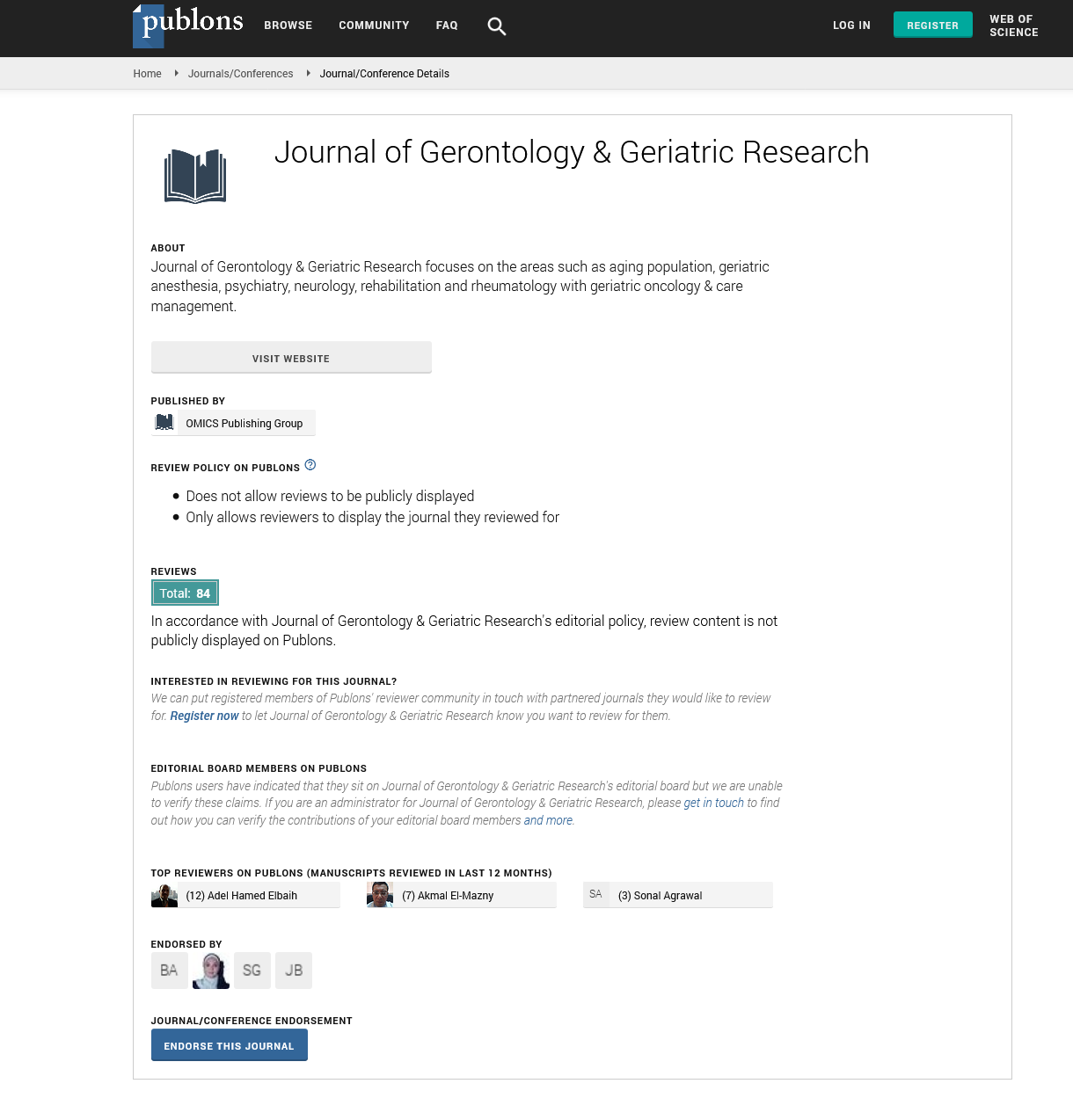Indexed In
- Open J Gate
- Genamics JournalSeek
- SafetyLit
- RefSeek
- Hamdard University
- EBSCO A-Z
- OCLC- WorldCat
- Publons
- Geneva Foundation for Medical Education and Research
- Euro Pub
- Google Scholar
Useful Links
Share This Page
Journal Flyer

Open Access Journals
- Agri and Aquaculture
- Biochemistry
- Bioinformatics & Systems Biology
- Business & Management
- Chemistry
- Clinical Sciences
- Engineering
- Food & Nutrition
- General Science
- Genetics & Molecular Biology
- Immunology & Microbiology
- Medical Sciences
- Neuroscience & Psychology
- Nursing & Health Care
- Pharmaceutical Sciences
Opinion - (2021) Volume 10, Issue 6
Healthy Aging & Alzheimer's Disease
Suresh Babu G*Received: 20-Jun-2021 Published: 30-Jun-2021, DOI: 10.35248/2167-7182.21.10.558
Opinion
Healthy ageing and Alzheimer's disease (AD) are linked to structural brain disturbance and the dedifferentiation of functionally specialised systems. Despite the fact that cortical thickness asymmetry is a global organisational characteristic of the cortex with probable implications for hemisphere specialisation, it has been largely ignored in investigations of cortical ageing. However, an asymmetrically arranged brain produces effective functional network organisation, which may help with cognition. As a result, as the cortex thins over time, the asymmetry of cortical thickness may shift, which could be indicative of diminishing brain function. We wanted to construct the pathways of asymmetric cortical thinning and analyse variations from these trajectories in AD patients using large longitudinal data sets from five healthy ageing cohorts and one dementia cohort.
The results of the few cross-sectional studies that have looked at the effects of age on cortical thickness asymmetry have been mixed. For example, between the ages of 5 and 60, a steeper association for thickness with age has been documented in both the right hemisphere (RH) and left hemisphere (LH) in prefrontal regions thought to be particularly sensitive in ageing. Nonetheless, the ENIGMA consortium's latest large-scale meta-analyses showed no evidence of age effects on frontal asymmetry, while studies have connected age to both loss and broad aggravation of thickness asymmetries established earlier in life.
Differences in sample size and test power, as well as linear modelling of cross-sectional age effects across developmental and ageing samples known to follow nonlinear brain trajectories over time, could explain some of the discrepancies. Divergent results could potentially be explained by methodological discrepancies, such as whether age effects on thickness asymmetry were investigated locally or vertex-wise across the cortex. Longitudinal lifespan studies that look at intraindividual asymmetry change have the potential to clarify contradictions and capture nonlinear asymmetry-change trajectories, but they are currently lacking in the literature. As a result, the fundamental question of whether and where the cerebral hemispheres thin at varying rates as people age is still unanswered.
Normal and pathological brain ageing may, at least in part, exist on a continuum, as regions of cortex that thin the most in healthy ageing overlap with regions that show more degeneration in AD, indicating accelerated change trajectories in AD and that normal and pathological brain ageing may exist on a continuum. As a result, hypothesised increases in asymmetry over the course of a healthy adult life may be more visible in AD. Early longitudinal studies suggest that disease progression may be associated with quicker LH degeneration in the medial and prefrontal cortex, despite cross-sectional findings being somewhat contradictory and meta-analyses reporting limited evidence for greater LH vulnerability in AD. Furthermore, new research suggests that the AD phenotype includes a system-wide loss of existing asymmetries. These findings demonstrate that changes in cortical asymmetry may be associated with greater intraindividual cognitive and clinical deficits in Alzheimer's disease over time, implying that structural asymmetry plays a role in healthy brain function. However, it is still unknown whether putative AD-related changes in cortical asymmetry are the result of an acceleration of progressive changes that occur throughout a healthy adult's lifespan.
Citation: Suresh Babu G (2021) Healthy Aging & Alzheimer's Disease. J Gerontol Geriatr Res. 10: 558
Copyright: © 2021 Suresh Babu G. This is an open-access article distributed under the terms of the Creative Commons Attribution License, which permits unrestricted use, distribution, and reproduction in any medium, provided the original author and source are credited.

